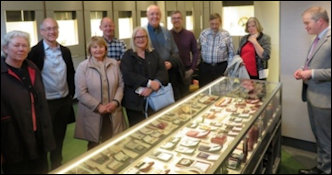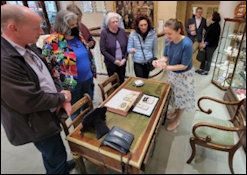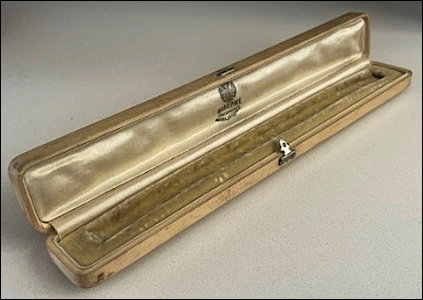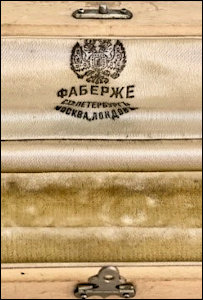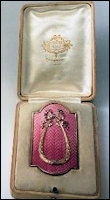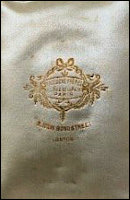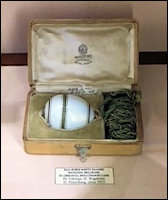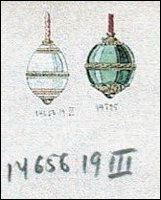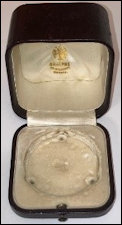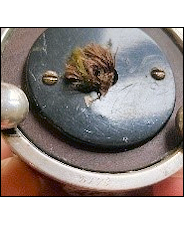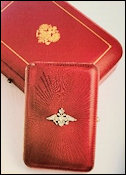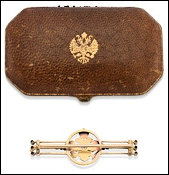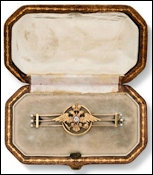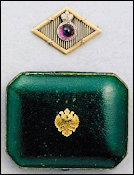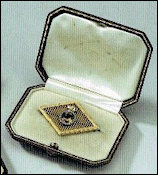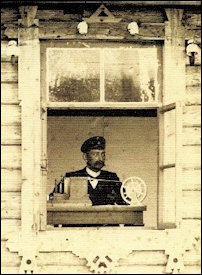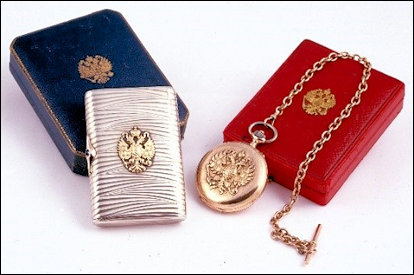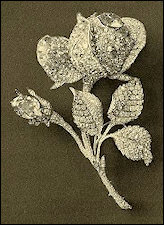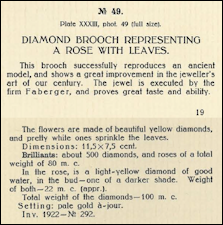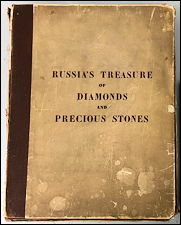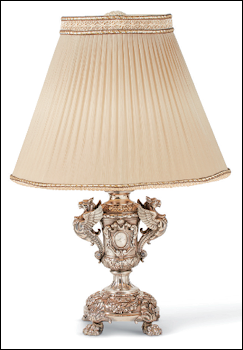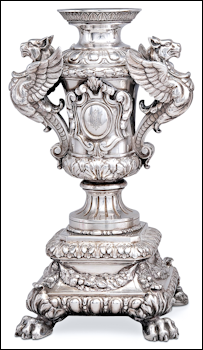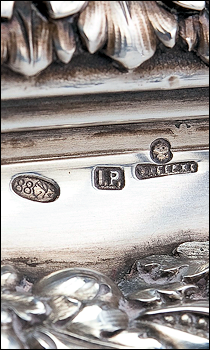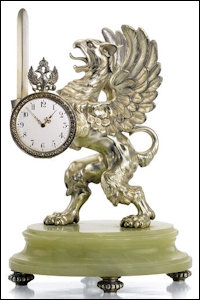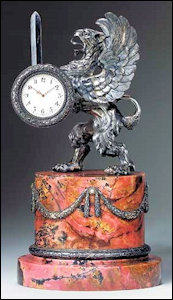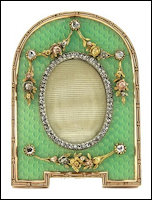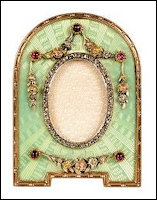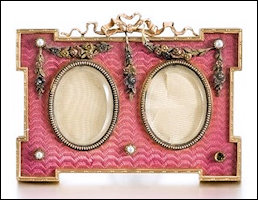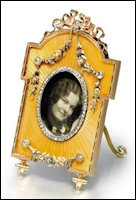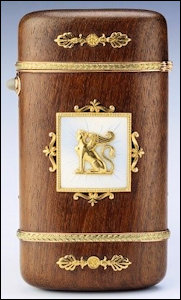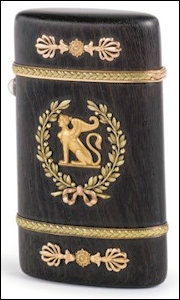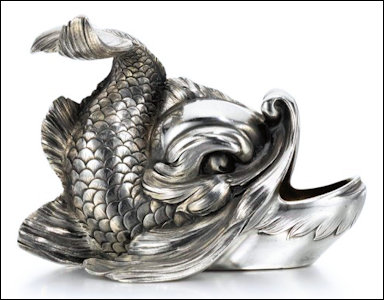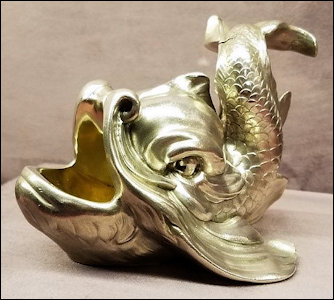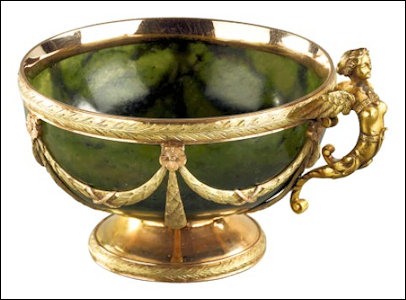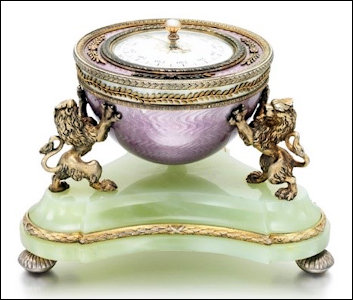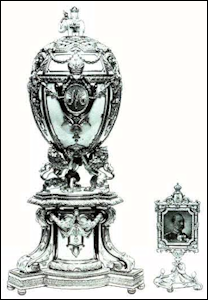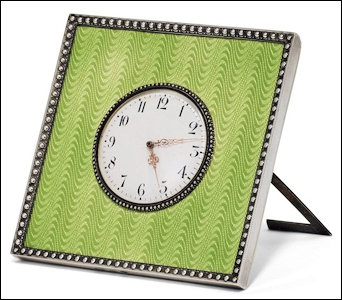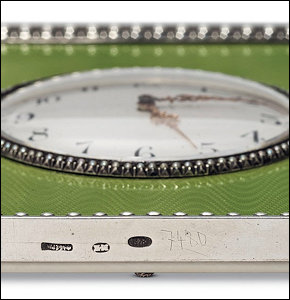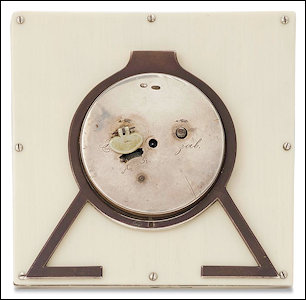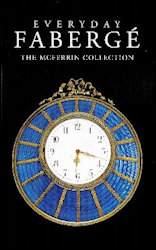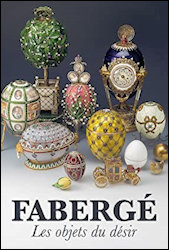Summer 2022
Victoria & Albert Museum Exhibition, November 20, 2021 – May 8, 2022
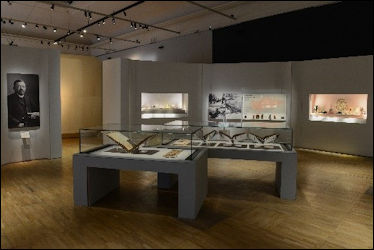 Exhibition Gallery 2: Examining Fabergé’s philosophy, materials and
Exhibition Gallery 2: Examining Fabergé’s philosophy, materials and
workshops. Vitrines with design albums from the Henrik Wigström
and Albert Holmström workshops (active 1903-1917)
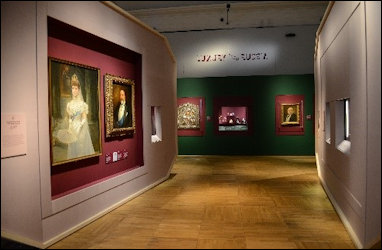 Exhibition Gallery 3: Fabergé’s activities in London revealed, and the
Exhibition Gallery 3: Fabergé’s activities in London revealed, and the
primary British patrons, Queen Alexandra (1844-1925) and
King Edward VII (1841-1910)
(Courtesy Wartski, London)
Reflections on a Fabergé Adventure
By Kieran McCarthy (United Kingdom)
Newsletter editor and publisher Christel McCanless kindly asked me to write something about the recently closed Fabergé exhibition. There is so much to tell. Enough tales and dramas perhaps to fill a book, which I am contemplating. My initial personal reflections of curating the exhibition were it was an emotional roller-coaster ride. The agreement of a loan for an Imperial Fabergé Easter Egg never seen before in the UK sent my spirits soaring late one evening, and news of an inevitable squeeze to the budget brought them crashing down the next morning. If you have put on a few pounds over the summer, I recommend curating as a weight loss plan. The frenetic level of adrenalin-producing activity in the build-up led to me dropping nearly two stone. My clothes could have done with altering before the opening, and I wish I had indeed seen a tailor. The stunning Duchess of Cambridge visited the show at the beginning and as I took her around my shirt fell out of my now-too-large trousers. Rows of paparazzi were in attendance and the pictures of the visit went across the world, appearing in magazines from China to Brazil. Luckily no one cared about me or my state of undress. It was all about the Duchess, what she was wearing and how high her heels were. Although I dodged attention there, an exhibition exposes you to your core elsewhere. Staging one is like running through a museum naked and inviting your peers to judge you. There is no place to hide, it is your idea, your creation, and you are responsible for it.
Thankfully with Fabergé it is near impossible to go wrong. The exhibition was, even if I say so myself, a thumping success. Sheer joy met its opening, multiple capacity-increasing ticket releases sold out, an accompanying talk was the museum’s most popular ever, and the catalogue even entered The Sunday Times’ best seller lists. Visitors adored it and many guests made repeated trips, one whom we all likely know, but won’t be named, made ten. Another friend flew especially from California, arriving in London in the morning, seeing the show, and flying back home the same evening.
Preparations for the event began two and a half years beforehand, in early 2019. Such a long run-in is needed to ensure lenders are willing to participate and do not have clashing commitments. Not long after the V&A agreed to stage the exhibition, the covid plague descended on us. To its credit, as vicious cuts were being made across the arts, the museum remained committed. In those dim days, behind its closed doors, Dr. Anna Ferrari, Hanne Faurby, and I secretly beavered away. The public announcement of our plans received a rapturous welcome. Up to that moment all we heard about was covid misery and closures. The beacon of a glittering exhibition on the horizon gave a crumb of hope for the return of culture to our lives.
The exhibition was the first to open in the museum following covid and the first dedicated to the great goldsmith’s work in the UK for nearly 20 years. Although the focus was Fabergé’s London branch and the dazzling clientele it attracted, the entire layered story of the firm was told. The resulting array of works, produced by Fabergé’s obsessively compulsive craftspeople intoxicated visitors. So too did the tales of friendship, loyalty, love, lust, and unashamed social climbing which accompanied them. The penultimate scene of the show was an ominous, claustrophobic space. In it, with a discordant soundscape playing in the background, the revolution, war, and demise of the firm were examined. This led to the story of Carl Fabergé’s exile, including poignant correspondence, revealing his broken heart and the circumstances of his tragic death. We even managed to find two of the hand grenades Fabergé helped produce for the Russian war effort. Telling the V&A I wanted to bring explosives into the museum generated great drama. After much explaining and with the help of the bomb squad, we finally managed to achieve it. From this intentionally gloomy setting the visitors moved into the final shining display of 15 of the revered Imperial Easter Eggs, the largest number gathered in a generation, to celebrate Fabergé’s legacy. The excitement in this room was palpable and heightened by the proximity of the masterpieces. Its spacious design allowed visitors to linger and view the eggs in the round, from mere inches away; only a sheet of glass, and of course a team of ferocious surrounding Gurkhas, prevented you from touching them. This sleek, mirror-clad space, containing close to a billion dollars’ worth of treasures, looked like the setting of a heist movie.
The design was created by the V&A’s in-house team. The brilliance of the museum’s staff was visible throughout the exhibition and behind the scenes too; where they oversaw the knotty issues of building the set, shipping to London, mounting, diligence, insurance, conservation, and so on and on. The museum’s approach to ‘interpretation’ – the question of how to inform the visitor through the narrative and labelling – particularly fascinated me. At first, the politics of language bored me, as did the ‘text hierarchies’ which demanded complex and interconnected works of art to be described in just a few lines. By the end, I relished the challenge of revealing Fabergé’s artistic genius in snippets of text. Seeds were planted in the first labels that flowered in later ones. When visitors told me they read every word and noticed the cross references, I was delighted. It was like writing a play, where hundreds of separate exchanges gel to tell a story.
The show was the result of a Wartski and Victoria & Albert Museum partnership. My colleagues and bosses (Nicholas, Margo and Hector Snowman, known as the ‘Snowpeople’) were central to the exhibition’s existence. Planning it took up a huge proportion of my time, which the Snowpeople permitted, and my colleagues filled in for me. We also relied on the firm’s longstanding Fabergé expertise and resources, without which the exhibition would certainly never have happened.
World events buffeted the exhibition at its beginning and end. The opening was surrounded by covid uncertainty, its conclusion witnessed Putin’s brutal invasion of Ukraine. In the anti-Putin uproar that ensued the show was in danger, luckily it survived, yet the hoped-for extension of its run was thwarted. In the shadow of the war the event gained a new significance. Some realised, given the new global realities, it may be another generation or even more before such treasures are united again.
Fabergé Enthusiasts Gathering in London
Visits with London Fabergé Jewelers, Wartski and Bentley & Skinner
(Courtesy Wartski, London | Timothy Adams)
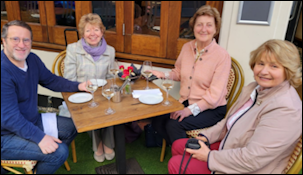 Informal Visits among Fabergé Enthusiasts
Informal Visits among Fabergé Enthusiasts
(Courtesy Timothy Adams)
Glowing reviews of over 200 Fabergé decorative objects shown at the Victoria and Albert exhibition appeared in the international press, and the group of Fabergé enthusiasts could not have agreed more – the variety of items presented in the venue were fabulous! An extra bonus was to become acquainted with fellow enthusiasts from England, Finland, France, Italy, Slovenia, and the USA. The choice to select from the many photographs shared by the enthusiasts was hard, since in addition to the V&A group tour there were also opportunities for in-depth ‘show & tell’ visits at two of London’s Fabergé shops. We extend our special thanks to Kieran McCarthy, and Katherine Purcell, co-directors at Wartski, and to Lola Rafieva at Bentley & Skinner.
Bibliography: A Closer Look at the Fabergé in London: Romance to Revolution Exhibition, Victoria & Albert Museum, November 20, 2021 – May 8, 2022 (Fabergé Research Newsletter, Winter 2021)
London Sunday Times best seller list included the official catalog, Fabergé: Romance to Revolution, by Kieran McCarthy and Hanne Faurby.
V&A exhibition highlights and the museum’s most popular ever talk, Rivals on Bond Street: Fabergé and Cartier feature curator Kieran McCarthy and author Francesca Cartier Brickell for a look at the relationship between the two master jewelers of the era. The talk is no longer on-line, however, the major topics are covered here.
The patronage and production that characterized Fabergé gifting with particular focus on Alma Pihl at the Fabergé exhibit in London. Same exhibition review by Kirsten Tambling published in Apollo, December 2021, pp. 68-74, is available under three different headlines: Internet, “How Fabergé Cornered the Market in Gifts for the Edwardian Elite”, cited on the cover of the hard copy journal, Apollo, the International Art Magazine, “Cracking Eggs: The Art of Fabergé”, and then on the actual text pages 68-74 with the title “Conservation Pieces”.
The design inspiration, vision and patronage contributing to the success of Fabergé’s London branch. Exhibition and book review by Cynthia Coleman Sparke in Jewellery History Today, Winter 2022, pp. 16-17 of Fabergé in London: From Romance to Revolution.
Review of the V&A exhibition devoted to Fabergé in London with an overview of layout and themes covered by Cynthia Coleman Sparke in CAA.Reviews, March 28, 2022.
Fabergé Presentation Cases
Fabergé Research Newsletter contributors fascinated with wooden boxes/cases in which the Fabergé firm elegantly presented its objects for commissions and Imperial presentation pieces, or just for the retail trade, share their insights. To share your observations or questions please. Contact:
Christel McCanless
-
Alice Milica Ilich (Australia), who gained her knowledge in the auction world is Searching for Missing Treasures.
-
James Hurtt (USA), a bell push enthusiast, lets Fabergé Presentation Cases Tell Their Stories 120 Years Later
-
Ulla Tillander-Godenhielm (Finland) adds new details for A Unique Genre: Fabergé Imperial Presentation Cases found during her research for the 2005 publication, The Russian Imperial Award System during the Reign of Nicholas II, 1894-1917.
Searching for Missing Treasures
By Alice Milica Ilich (Australia)
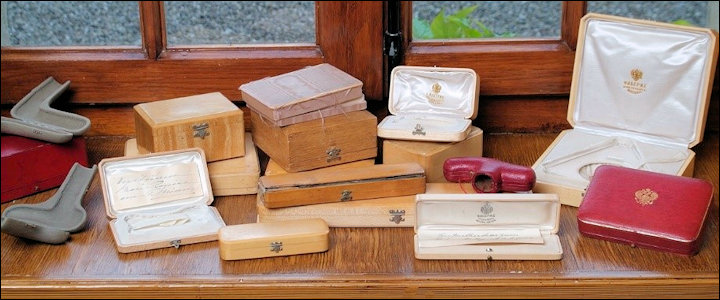 (A.) Variety of Fabergé Fitted Cases in the Mirabaud Collection, Switzerland
(A.) Variety of Fabergé Fitted Cases in the Mirabaud Collection, Switzerland
(Ilich, Alice Milica, et al. A Gentleman’s Obsession, 2007, pp. 122-123)
Carl Fabergé (1846-1920), the consummate businessman, knew how to showcase the outstanding creations by encasing them in a perfectly crafted box and adding the firm’s name under the Imperial warrant. Today’s Fabergé collector also recognizes a hand-crafted object in its original case supports the provenance and the value. The firm’s family business was structured innovatively during its existence with the varied production out-sourced, yet the independent workmasters and their ateliers were within the confines of a significant four-story building completed in 1901 at Bolshaya Morskaya in St. Petersburg, Russia. For example, Simo Käki (1819-1896), Fabergé’s foremost wooden case maker, had a workshop in the courtyard of the main complex with easy access to all the other artisans. Like many of Fabergé’s team, the case-maker as a young person had left Finland to seek his fortune and learn a trade in the bustling city across the Gulf. After he died in 1896, his atelier was continued by his wife, Matilda, until her retirement in 1911.
1
The cases from the beginning of the 20th century were simple in design, housed the object securely, and were made from a variety of woods, i.e., beech (C.), alder (D.), and elm (J.). The preferred medium (B.) was holly wood (ilex rugosa) growing naturally on the Sakhalin Island in Russia’s Far East above Japan. It is the whitest-color wood known with a close grain, a fine texture, and is a very appealing and easily-recognized material. The wooden cases were lined with cream-colored silk and velvet, stamped with the Imperial warrant, the firm’s name and location(s) of the branches in St. Petersburg, Moscow, Odessa, Kiev, or London, in gold or black on the lining under the lid.
Patterns for original fitted Fabergé cases:
-
Holly wood cases contain the more delicate and smaller items, such as jewelry, charkas, cane handles, and clocks. Jewelry cases vary, but collectors easily identify the imprint of a single brooch or pin originally contained in the Fabergé box.
(B.) Holly Wood Case for a Fabergé Bracelet with Fabergé Imperial Warrant Stamped on the
Interior Silk Lining of the Lid – St. Petersburg, Moscow, London, and Presentation Case Clasps.
(Author’s Collection)
-
A smaller number of fitted cases are made of cardboard and covered with silk or cloth on the outside.
-
The Cabinet of His Imperial Majesty had specially-designed cases identifying the item as an Imperial gift. Most often crafted in red Morocco leather (M.) and stamped in gold with the Imperial double-headed eagle.
-
More solid cases made of hardwood hold larger items, such as silver tea and coffee services, flatware, and presentation kovshi.
-
Clocks and frames frequently appear in rectangular cases with a narrow height and a cut-out for the mechanism.
-
Hand seals and parasol handles were usually placed in cases horizontally, whereas cups and kovshi were often placed into larger upright cases. A few parasol handles have form-fitting soft cloth cases.
-
A unique case application is seen with a pair of Rothschild candle sticks standing upright in the original fitted case and beautifully displayed with the box open. Similar upright cases house Fabergé flower studies.
Any leads on what once was elegantly presented in the two original cases (C. – D.) are welcomed, Contact: Alice Milica Ilich
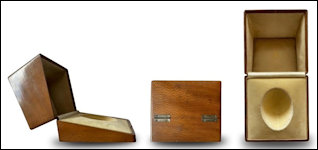 (C.) Square Box: European beech (Fagus sylvatica) with an
(C.) Square Box: European beech (Fagus sylvatica) with an
interior ovoid-shaped compartment (8.5 cm long x 6.5 cm wide)
may have contained an item the size of a goose egg more
significant than the usual small Easter egg pendants gifted
at Easter in keeping with the Russian Orthodox tradition.
Fabergé’s Imperial Warrant – St. Petersburg, Moscow,
ca. 1890-1900.
(Author’s Collection, Photographs Fiona O’Driscoll)
 (D.) Rectangular Box: Alder (Alnus glutinosa) with an interior compartment (14 cm in diameter x 18 cm
(D.) Rectangular Box: Alder (Alnus glutinosa) with an interior compartment (14 cm in diameter x 18 cm
long including the handle) may have held a charka, a traditional Old Russian-style drinking vessel.
Fabergé Imperial Warrant – St. Petersburg, Moscow, ca. 1890-1900.
(Author’s Collection, Photographs Fiona O’Driscoll)
Fabergé objects and their presentation cases can be faked. To verify authenticity, one needs to carefully examine the joinery of each box, the definition of the metal catch2, the type, shape and number of hinges, as well as the quality and color of the silk and velvet. Following the overthrow of the Romanov dynasty in 1917, individuals who fled carried the bare minimum, including jewelry or gold ducats to be sold for survival. Fitted cases were bulky and likely left behind. Yet empty cases surface from time to time at charity shops and auctions. Combining an original article with its bespoke box increases the object’s value, adds to its provenance, and generates a true feeling of reunification and gratification.
Fabergé Presentation Cases Tell Their Stories 120 Years Later
By James Hurtt (USA)
Fabergé objects lost their original cases not only while Russians were fleeing their homeland after the revolution (1917-1923), but also during and after World War II when the original owners, Russian and Germans, and other nationalities were fleeing the bombing and facing displacement. Even more recently – 20 to 55 years ago – some collectors may have had the original box, yet by the time the item changed hands again the box did not accompany it. In an ongoing research project on a green enameled etui or cigarette case
3 now in the McFerrin Collection, it was discovered the original case had survived at least up to 1950, and was lost by 2005
4, when the object was offered again at auction.
Wooden cases made with specialized inserts:
-
Ovoid depression to possibly cradle an egg (C.)
-
Depressed outline to possibly secure a charka, bowl, kovsh, or shallow compote? Shape and dimension suggest it is not a case for a clock or a bell push (D.)
-
Separate compartment to hold a silk-wrapped electrical wire for an enameled egg bell push (H.) The production sketch recording the completed object retained by the Fabergé studio for future reference is extant, and
-
Some cases were not made of wood or leather, but of cardboard covered silk.5
Dating Fabergé objects by identifying the imprint on the interior silk lining where the firm had branches is possible. When the name St. Petersburg, Fabergé’s anchor location, was changed from the German sounding name to the more Russian name of Petrograd on September 1, 1914, it is reflected in the Fabergé stamp. If the item was made in St. Petersburg/Petrograd then the name of that city is first and followed by a combination of either Moscow, Odessa, Kiev, or London. An item made and sold from Moscow (I.), the other major production center has Moscow listed first. The Fabergé logo on the interior lid may serve as a source of authentication when the objects – especially carved animals – are not marked with the Fabergé name or that of the firm’s workmaster.
Branches of the Fabergé firm reflected on the interior lining of the lid:
| St. Petersburg (1842 - August 1914) | Petrograd after September 1914 |
| Moscow (1887-1918) | Studios in St. Petersburg and Moscow designed and produced the majority of the Fabergé objects. |
| Odessa (1900-1918) | Limited workshop made and sold smaller jewelry at Deribasovskaya street 33 from ca. 1900-1903. A commemorative plaque in the “Passage” of the building honoring Karl Fabergé exists. (Fabergé Research Newsletter, Winter 2010-2011) |
Kiev (October 1906-1911)
London (September 1903 - January 1917)
| The imprints for Kiev or London would never appear first, since no objects were made in these retail outlets. British commissions for London clients, if stamped at all on the silk, have St. Petersburg as their point of origin. |
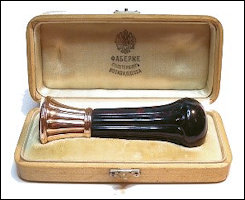 (E.) Fabergé desk seal, Mikhail Perkhin
(E.) Fabergé desk seal, Mikhail Perkhin
(active 1886-1903), stock number 6743,
in original silk and velvet lined fitted holly wood
case, the lid silk stamped in Cyrillic Fabergé, St.
Petersburg, Moscow, Odessa below the
Imperial warrant, 1896-1903.
(Courtesy Wartski, London)
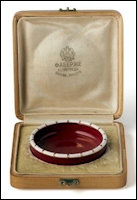 (F.) Fabergé dish (1914)
(F.) Fabergé dish (1914)
in its original silk and velvet
lined fitted holly wood case,
the lid silk stamped Fabergé,
Petrograd, Moscow,
London in Cyrillic beneath
the Imperial warrant, box
stamped ‘Petrograd’ rather
than ‘St. Petersburg’ dates
the tray after August 1914.
(Courtesy Wartski, London)
(G.) Original Fabergé cases were very stylish
and attractive to donors and recipients. When the
French jeweller, Lacloche Frères
(1901-1931), purchased the ca. 200 remaining
objects from the London Fabergé branch in 1917,
the new owner only replaced the lid’s silk with
the firm’s imprinted name.
(McCarthy, Kieran. Fabergé in London,
2017, pp. 212-213)
Holly Wood and Elm Cases:
(H.) Fabergé bell pull with silk-wrapped electrical wire compartment
in situ at the New York dealer, A La Vieille Russie (Author’s
Photograph), and production sketch (Tillander-Godenhielm Ulla, et al.,
Golden Years, 2000, p. 163, plate 275). Stamped on the box lining
Petrograd, Moscow, London, scratched stock number 25208
suggests object was finished between July-Sept in 1914, and boxed
for sale after September 1, 1914, when St. Petersburg was
renamed to Petrograd.
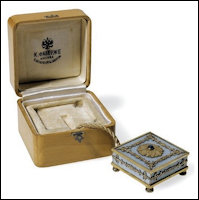 (I.) Fabergé silver-gilt and enamel
(I.) Fabergé silver-gilt and enamel
bell-push, scratched stock number
18393, Moscow, St. Petersburg,
Odessa, 1899-1908.
(Sotheby’s London,
June 12, 2008, Lot 613)
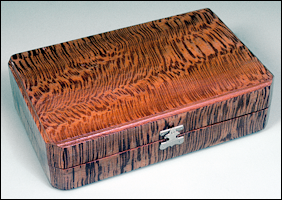 (J.) Fabergé elm case with an unusual pattern from
(J.) Fabergé elm case with an unusual pattern from
the casemaker studio of Matilda Käki, who continued
her late husband’s workshop from 1896-1911.
(Tillander-Godenhielm, Ulla. Fabergé ja hänen
suomalaiset mestarinsa [Fabergé and
His Finnish Workmasters], 2008, p. 388)
A
pioneering study6 with illustrations about Fabergé’s use of wood was written 18 years ago by Kieran McCarthy, co-director of Wartski, London.
Leather-covered Cases:
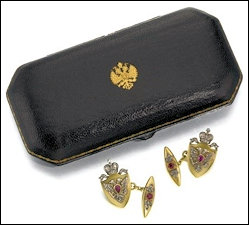 (K.) Imperial leather case with double-headed
(K.) Imperial leather case with double-headed
eagle insignia on the object and outside of the
brown case. Fabergé Imperial cufflinks, August
Hollming (active 1886-1903), scratched stock
number 2315, ca. 1905, no lid imprint
details listed.
(Sotheby’s London, November 29, 2016, Lot 335)
(L.) Wooden case covered in brown leather. Fabergé silver-mounted wooden bell push, Viktor Aarne
(active: 1880-1904), St. Petersburg, Moscow, 1899-1908, scratched stock number 2148 (illustrated).
Probably made between January to November 1899 based on the stock number,
lacks Odessa stamp on the interior lid.
(Sotheby’s London, June 10, 2009, Lot 549; Private Collection)
All rules have exceptions!
-
Match holder with lid lining stamped in Cyrillic ‘K. Fabergé’ with Imperial warrant (Christie’s New York, April 19, 2002, Lot 91)
-
Squirrel: Stamped in Cyrillic ‘K. FABERGE’ with the Imperial warrant (Christie’s London, June 13, 2006, Lot 124)
-
Kovsh: Stamped in Russian ‘K Fabergé Moscow St. Petersburg Kiev Odessa Nizhnii Novgor[od] Fair London’. Case lining stamped with all the cities including the annual Nizhny Novgorod Fair held since 1817. The Fabergé firm participated in 1896 and was awarded the State Coat of Arms.7 (Christie’s London, October 25, 2000, Lot 518)
The closures (B., H.-J.) on most of the smaller boxes open by releasing a clasp, or by pushing a button to “unlock” the box. They were fastened upside down with the clasp portion on the bottom rather than fixed to the top lid, and then pulled up to secure. At this time, it is not known why this box closure design was used by Fabergé, and other Russian firms, the competing jeweler A.I. Sumin, and even the Imperial Stone Carving Factory. The Simo Käki workshop furnishing the boxes for Fabergé objects probably commissioned these clasps as well as the minute hinges/charniers from an unknown supplier in St. Petersburg. The white metal clasps on the boxes have not been analyzed in the published literature, nor to my knowledge tested. During Fabergé’s time the white metal was composed of copper, nickel, and zinc – “Nickel Silver” or “German Silver”. The advantages were a strong closure and when polished gave the appearance of silver without the drawback of tarnishing. The larger oak boxes have brass hardware.
A Unique Genre: Fabergé Imperial Presentation Cases
By Ulla Tillander-Godenhielm (Finland)
A rainbow of colors with red imperial presentation cases (M.) being the most frequently used for Fabergé objects presented by the Imperial rulers for significant deeds or outstanding service, are still known today. By tradition awards presented from the sovereign were ‘in purple’. Since ancient times emperors, kings, and princes were said to be born ‘in purple’ and the symbol of power was a purple cloak or dress. The color for the leather presentation cases was extracted from bolinus brandaris (M.), a rare marine shell. Other leather colors: Brown (K., L.), beige (N.), green or reddish-brown (O.), blue (Q.), were used occasionally, but an explanation for the variation in color has not been found.
Typical Cabinet Imperial Presentation Cases Used after 1900 with Double-headed Eagle Imprint on the Exterior Lid, Fabergé Workmaster August Hollming (A*H, died in 1913, dates for his objects should be cited 1908-1913.)8
(M.)
Bolinus brandaris shell; Imperial presentation cigarette case, August Hollming (1908-1913, footnote 8), St. Petersburg, gilt-silver, rose-cut diamonds and red guilloché enamel, scratched stock number
3102, 9 cm. Provenance: Presented by Dowager Empress Maria Feodorovna to Anders Ahonen, the director of the Finnish Railways. Returning to Russia in August 1914 from a visit to her sister Queen Alexandra in England, the Germans did not allow the Empress to travel through their country, so she was forced to take the long detour by train through Sweden and Finland. The trip was organized by the authorities of the Finnish railroads, who in great haste restored the specially outfitted imperial wagons used by Alexander II on his trips to Finland. (Tillander-Godenhielm, Ulla.
The Imperial Award System during the Reign of Nicholas II, 2005, p. 217)
Update: Cigarette case has a new owner. (Courtesy Finnish Railway Museum, Hyvinkää, Finland; Photograph by Katja Hagelstam, Tillander-Godenhielm, Ulla. Fabergé. His Masters and Artisans, 2018, p. 173)
(N.) Imperial presentation brooch, August Hollming (footnote 8), scratched stock number 2564, Imperial Cabinet records date it to June 12, 1910, presented to Mrs. Rau on March 8, 1911, without an interior lid stamp. (Christie’s London, July 1-21, 2020, online auction, Lot 64)
(O.) Imperial presentation brooch, August Hollming (footnote 8), gold, cabochon amethyst surmounted by Imperial crown, in its original green leather Cabinet box stamped with a gilt double-headed eagle.
Provenance: Presented to Mlle. Louise Ulrika Rinman, matron of the household of the Stockholm palace, during the state visit of Nicholas II to Sweden, 1909. (Tillander-Godenhielm, Ulla. The Russian Imperial Award System during the Reign of Nicholas II, 2005, p. 349)
Similar Imperial presentation brooch by Fabergé, [August Hollming (footnote 8), St. Petersburg], gold, oval faceted garnet. This brooch is in a reddish-brown leather Cabinet box stamped with a gilt double-headed eagle. Recipient unknown. (Christie’s, New York, October 23, 2000, Lot 115)
The name of the jeweler (N. – O.) was not imprinted on the silk interior of the lid, because the gifts were official presentations symbolically given by the sovereign himself and part of the Imperial award system. The maker of the piece was subordinated in this context. But no rule without an exception! One example of an imperial presentation gift with the name of the jeweler printed on the silk lining of the box exists. Court Jeweler Bolin, St. Petersburg, supplied the Cabinet of His Imperial Majesty with a snuffbox (P.), which was presented by the emperor to the Swedish minister of Navy Count, Carl August Ehrensvärd during the state visit in Stockholm 1909.
9 Fitted cases for imperial awards were provided by the makers of the objects which enabled the jeweler to present the object and its case as one elegant gift.
A personal note: When I first started working in our family jewelry business, A. Tillander (founded in 1860 and still in existence today), our case-maker’s wife was often in the back-room of our workshop measuring freshly made objects and jewels to discuss cases to be made for them. Matilda Käki (J.), wife of Fabergé’s pre-eminent case maker Simo Käki10, continued his workshop for 15 years after he died in 1896. In-depth research on the Imperial award cases has not been attempted, so our knowledge about them is limited to the small number of extant cases.
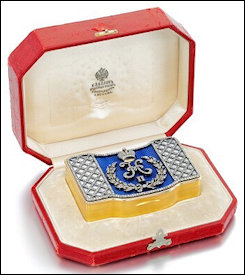 (P.)
(P.)
(P.) Imperial presentation box with snuffbox, Court Jeweler Bolin, St. Petersburg, presented by Nicholas II to Swedish minister of Navy, Count Carl August Ehrensvärd during the state visit in Stockholm 1909. (Tillander-Godenhielm, Ulla.
The Imperial Award System during the Reign of Nicholas II, 2005, p. 347; Sotheby’s London, June 9, 2021,
Lot 5)
(Q.) Henrik Starck (1863-1918) served his entire working life at the Telegraph Service in the Grand Duchy of Finland. Upon his retirement after 30 years of service, he received a Buhre gold watch with a chain from the Cabinet of His Imperial Majesty Nichols II in a red Morocco leather case (right). In 1912, while serving as head of a temporary telegraph station in the archipelago, Starck took part in a life-saving expedition. In gratitude for his assistance Dowager Empress Maria Feodorovna presented a cigarette case in silver decorated with a gold double-headed eagle in a blue leather case (left) to him. The enclosed cigarette case was made by A. Tillander. (Photograph Katja Hagelstam, Tillander-Godenhielm, Ulla. The Imperial Award System during the Reign of Nicholas II, 2005, pp. 367-369)
ENDNOTES:
1 Tillander-Godenhielm, Ulla. Fabergé: His Master and Artisans, 2018, pp. 264-265.
2 Details in James Hurtt contribution in this essay.
3 Fabergé: The McFerrin Collection – The Opulence Continues, 2016, p. 130, Number 30.
4 Christie’s New York, March 18, 2005, Property from the Estate of Mrs. Charles W. Engelhard, Lot 75.
5 Sotheby’s London, June 2, 2015, Lot 215.
6 McCarthy, Kieran. “Forgotten Fabergé” (Title varies: “Luxury in Wood: Forgotten Faberge”), The Antique Dealers & Collectors Guide, May – June 2004, pp. 40-42.
7 von Habsburg, Géza, and Marina Lopato. Fabergé: Imperial Jeweler, 1993, p. 62 as reported by Eugene C. Fabergé [eldest son of Carl Fabergé] in a letter to the Russian Imperial Cabinet dated October 16, 1910.
8 Information shared by Ulla Tillander-Godenhielm.
9 Snuffbox (P.) in red Morocco leather case (Tillander-Godenhielm, Ulla. The Imperial Award System during the Reign of Nicholas II, 2005, p. 347; Sotheby’s London, June 9, 2021, Lot 5)
10 Tillander-Godenhielm, Ulla. Fabergé. His Masters and Artisans, 2018, pp. 264-266.
Fabergé Diamond Brooch Representing a Rose with Leaves in the 1925 Fersman Portfolio
A collaborative effort by Katrina Warne (UK), Rose Tozer, and Christel Ludewig McCanless (USA) takes a closer look at an illustration and description in the original 1925 English edition of the Fersman Portfolio and culminates with a new discovery woven into the chronology of a private gift to Empress Alexandra Feodorovna (1872-1918).
Recreated Fabergé Diamond Brooch Based on the 1925 Fersman Portfolio
By Katrina Warne (UK)
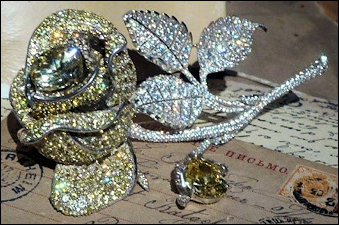 (A.) Lyngvild Reproduction of Diamond Brooch In Situ
(A.) Lyngvild Reproduction of Diamond Brooch In Situ
at the Museum South East Denmark in Vordringburg
(Photograph by the Author)
LEFT PICTURE: Part 2, Plate XXXIII | RIGHT PICTURE: Part 2, Text
(B.) Fersman Plate XXXIII: Fabergé Diamond Brooch Representing a Rose with
Leaves, No. 49, Inv. [Inventory], 1922-No. 292. (Russia’s Treasure of Diamonds
and Precious Stones, Fersman, A. E. (Aleksandr Evgenevich), 1883-1945,
Free Download, Borrow, and Streaming : Internet Archive, Part II, pp.19-20)
On a recent visit to the exhibition
Blood and Diamonds (on view until October 23, 2022) I spotted a
Fabergé Diamond Brooch recreated by Jim Lyngvild, Danish designer, writer, photographer, at the Museum South East Denmark in Vordringburg, an hour south of Copenhagen by train. Lyngvild has done a marvelous job recreating lost French royal and Russian imperial jewelry based on photographs and detailed descriptions from the original 1925
Fersman Portfolio. With stones created in a laboratory, set in silver, the reproduction pieces are made to size, and some of them are very large indeed. A lot of the jewelry inventoried by the Soviets in 1922, and sold by them in the 1920’s was immediately recognizable. During Russian imperial times these jewels were worn by Empress Alexandra, Grand Duchess Elisabeth Feodorovna, Grand Duchess Vladimir, and Grand Duchess Maria Pavlovna, the Younger, and others. The reproduction (A.) of the original Fabergé rose brooch (B.) with yellow diamonds approved by Emperor Nicholas II and given to his wife Alexandra in 1896 is illustrated in the massive catalog,
Blod & Diamanter – Blut & Diamenten (in Danish and German) by Jim Lyngvild and Charlotte Lindhardt. The text panel for the recreated brooch in the Danish exhibition identifies the coronation year incorrectly as
1894. The
coronation of Nicholas II took place on Tuesday, 14 May (
O.S., 26 May N.S.) 1896.
Historical facts:
The 1925 original Fersman catalog (350 copies) printed in separate French and English editions, 300 printed in Russian.
The article “Fersman Portfolio – Fabergé Jewels – Nuptial Crown” by Christel Ludewig McCanless and Annemiek Wintraecken, Fabergé Research Newsletter, Fall 2010 suggests ten English language editions are in American libraries, and one each in Berlin and Munich. Two copies in French with the title, Les Joyaux du Trésor de Russie, are in a British private collection and a Paris library. The authors are not aware of any German editions.
Auction records reveal four English copies have come under the hammer:
1987 Sotheby’s New York sold a copy to Theodore Horowitz for $2,640, including the buyer’s premium. It was sold 10 years later by Christie’s Geneva for $21,304, and is now in the Liddicoat Gemological Library, Gemological Institute of America (GIA), Carlsbad (CA).
2000-01 Sotheby’s London sold two copies for $21,084 and $45,992, inclusive of the buyers’ premiums.
2007 A copy with an Ex Libris Umberto, Prince of Piedmont, later King Umberto II of Italy sold at Christie’s London for $141,984.
Two French editions have sold at Christie’s – in Geneva (2008) a copy signed by Alexander E. Fersman realized $71,861, and in London (2010) a copy realized $64,230.
On October 14-15, 2010, an English edition with an Ex Libris of the Dallas jeweler, Arthur A. Everts Co., was auctioned by Heritage Auctions, Beverly Hills, (CA).
2016 Rose Tozer, senior librarian at the Liddicoat Gemological Library and Information Center, and her team at the Gemological Institute of America in Carlsbad (CA) oversaw the production of a high-quality scan from their English edition in the GIA collection. The Fersman Portfolio is no longer under copyright restrictions, therefore the GIA scan (B.) is available to everyone for free on Internet Archive: Russia’s Treasure of Diamonds and Precious Stones, Fersman, A. E. (Aleksandr Evgenevich), 1883-1945, Free Download, Borrow, and Streaming.
2022 A paper and hard copy reprint (C.) with an introduction by Paul Gilbert was published.
Comparing the 1925 Fersman Portfolio and the 2022 Gilbert Reprint Edition
By Rose Tozer (USA)
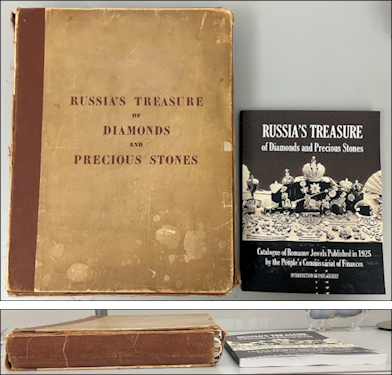 (C.) 1925 Fersman Portfolio and (D.) 2022 Gilbert Reprint Edition
(C.) 1925 Fersman Portfolio and (D.) 2022 Gilbert Reprint Edition
(Photograph Courtesy of the Liddicoat Library, GIA)
Paul Gilbert has reproduced his personal copy of the 1925
Fersman Portfolio, English language edition, in both hardback and paperback formats. I am reviewing the paperback format (D.). The benefits of Gilbert’s production are portability and affordability. Fersman’s 1925 catalog is 12 1/2” W x 16” H x 2 1/4” D and weighs 13 1/2 lb (6,140.4 g). Gilbert’s paperback is 8 1/2” W x 11” H x 1/2” D and weighs 1 lb (566 g). If one can find an original Fersman it is thousands of dollars, but Gilbert’s hardback and paperback formats are $35/$25 respectively.
Gilbert describes his work as a facsimile but it would be better described as a reprint. A facsimile is an exact copy of a work, including blank pages and original page numbering. A reprint is a work reprinted in a different form. The original catalog is in four physically separated parts (I, II, III and IV): text and 100 black & white photographs (25 photographic plates per Part). Each Part has its own pagination as well. The printing quality in Gilbert’s reprint is not ideal: blurry and grainy but still readable. While the photographs look better than the text, they are also not as sharp as in the original portfolio. In reproducing the text pages, Gilbert chose to eliminate Fersman’s original pagination. A decision made anticipating confusion for the reader to see two sets of page numbers.
On the title pages for Parts II, III and IV, Gilbert has added subtitles which do not exist in the original. Each text section includes a monographic article, and each article has its own title. The articles provide a wealth of knowledge for the history of the Russian treasure. However, the topic of each article has nothing to do with the jewelry described in each Part. By providing a subtitle on a title page, it gives the reader the impression all of the information in its respective Part is about a particular topic. For example, “Part II: Coronation Regalia” (Gilbert 2022, unnumbered page placed between pp. 49-50), while the paper is about the Russian coronation regalia, the actual pieces (namely the Imperial crown, Sceptre and Orb) are described in detail and photographed in Part I.
Gilbert included an image of Professor Fersman on page 9. This image does not appear in the original Fersman Portfolio. To distinguish between a facsimile versus a reprint are relatively minor in the grand scheme. For those who like to have a book in hand, as opposed to a digital copy, the reprint allows you easy access to the Fersman Portfolio.
[Ed. Note: The Fabergé Diamond Brooch on Plate XXXIII is on p. 71 of the Gilbert reprint, the text (blurry) is on pp. 57-58. Unfortunately, the plate is without a link from the object illustration to the descriptive text.]
Chronology of the Fabergé Diamond Brooch from 1922-2022
By Christel Ludewig McCanless (USA)
Research contributions about the history and content of the
Fersman Portfolio have appeared over the years in the
Fabergé Research Newsletter.
1 Two specific articles and other resources shed further light on the Fabergé brooch yielding an updated timeline in this article:
-
“Fersman Portfolio – Fabergé Jewels Reviewed” by Annemiek Wintraecken and Christel McCanless (Fabergé Research Newsletter, Spring 2012) discusses the brooch in more depth. (B.)
-
The Russian authors, Galina Korneva and Tatiana Cheboksarova in “Coronation of Nicholas II and Empress Alexandra Feodorovna: Fabergé Brooches Created for Two Empresses” (Fabergé Research Newsletter, Spring 2018) added exciting details, namely a Fabergé drawing approved by Emperor Nicholas II on July 9, 1895, and a Fabergé invoice on February 28, 1896. (E.)
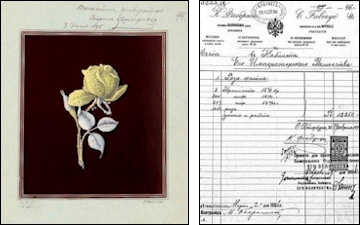 (E.) July 9, 1895 Fabergé Drawing Approved by Nicholas II
(E.) July 9, 1895 Fabergé Drawing Approved by Nicholas II
February 28, 1896 Fabergé Invoice.
(Korneva, Galina, and Tatiana Cheboksarova, “Coronation of Nicholas II
and Empress Alexandra Feodorovna: Fabergé Brooches Created for
Two Empresses”, Fabergé Research Newsletter, Spring 2018)
(B.) 1922 Inventory by the People’s Commissariat of Finances 1925
Fersman Portfolio, Plate XXIII: Fabergé Diamond Brooch Representing a Rose
with Leaves, No. 49, Inv. [Inventory], 1922-No. 292
(Fabergé Research Newsletter, Spring 2012)
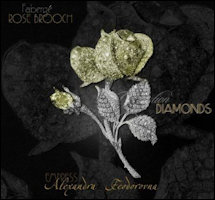 (F.)
(F.)
(Courtesy Ursula Butschal)
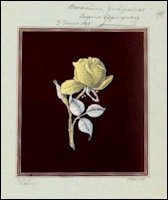 (G.)
(G.)
(Courtesy RGIA)
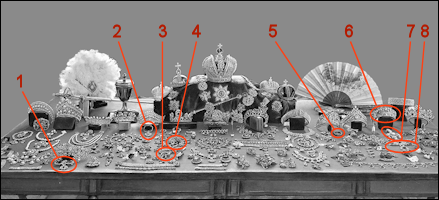 CLICK THE ABOVE PICTURE FOR A LARGER VIEW
CLICK THE ABOVE PICTURE FOR A LARGER VIEW
(H.)
(Courtesy Marie E. Betteley, Rare Jewels and Treasures)
(F.)
February 13, 2017 Royal Magazine (English and German text) with detailed description of the original
Fabergé Diamond Brooch.
(G.) Exhibition Closed 2021 175th anniversary of the birth of Carl Fabergé [1846-1920] exhibition of archival documents, Carl Fabergé – Jeweler of His Imperial Majesty, opened in the Russian State Historical Archive (RGIA), St. Petersburg, Russia… “the highest approved drawing of a rose brooch made by Fabergé for a coronation gift to Empress Alexandra Feodorovna. RGIA. F. 468. Op. 8. D. 195. L. 44b.”
(H.) September 2022 Three cheers for Sarah Ostrye, GIA digitization librarian, who identified the Fabergé Diamond Brooch (Object #4) in the Fersman Portfolio (English edition). Fabergé objects (#1-3 and 5-8) were identified in the Fersman Portfolio (Fabergé Research Newsletter, Spring 2012). Are there other Fabergé finds? Contact: Christel McCanless
Russian Crown Jewels – Gokhran, 1922. Identified Fabergé Items in Red Circles (Fersman Portfolio, Part I, Frontispiece)
-
#1 Sévigné Brooch
-
#2 Emerald
-
#3 Plastron
-
#4 Diamond Brooch
-
#5 Ceylon Sapphire
-
#6 Turquoise Diadem
-
#7 Turquoise Brooch
-
#8 Slave Necklace One of the Two Ceylon Sapphires
Fabergé’s Use of Molds and Pre-cast Decorative Applications
By Timothy Adams (USA)
Jewelry firms, including the well-known Russian studios of Carl Fabergé in existence from 1872-1917, streamlined their workshop production to be as efficient as possible to meet the demand for their luxury products. One expedient shortcut was the use of molds and casts for parts of large silver pieces (lamps, tazzas, and clocks), and for smaller decorative applications (garlands, laurel vines and acanthus leaves, rosettes and swags), all cast in multiples to be added as the final decorative touch on each handcrafted object. Workshops from St. Petersburg to Moscow used castings made in molds. Goldsmith apprentices learned their future trade by hand-finishing the molded pieces before the final object was assembled. Objects with similar decorative details from four Fabergé workmaster’s studios are presented with brief descriptive details and auction links.
| Fabergé Objects Made in Molds |
| Large silver pieces from molds (A.) |
| Garlands (B.) |
Classical motifs: Laurel vines, acanthus leaves,
rosettes, and swags (C.) |
| Classical mythological creatures as ornaments (D.) |
| Lost wax figures cast in the round (cire perdue) (E.) |
| Fabergé Workmasters Represented |
Julius Rappoport (I.P.  – active 1883-1908, – active 1883-1908,
upon his retirement became First Silver Artel, ICA) |
| Mikhail Perkhin (М.П.) – active 1886-1903 |
Viktor Aarne (BA  – active 1891-1904) – active 1891-1904) |
Henrik Wigström (H.W.  – active 1903-1917) – active 1903-1917) |
(A.)
Large silver pieces from the Julius Rappoport (I.P.

) Fabergé workshop, a lamp, and a tazza (only one of the pair shown) feature identical parts from the same mold – winged griffins, a cartouche for a special inscription, and lion paws.
Romanov Family Emblem (Griffin with Sword and Shield)
LEFT: Fabergé Clock, Bowenite Base, Julius Rappoport (I.P.  ),
),
Scratched Stock Number 764
(Sotheby’s London, June 4, 2013, Lot 536)
RIGHT: Fabergé Clock, Rhodonite Base (ICA, Successor to Rappoport
Studio), Scratched Stock Number 18209, Silver Swags, a Tasteful Classical
Aesthetic, Retailed by Fabergé.
(Christie’s London, November 30, 2004, Lot 529)
(B.)
Garlands used by Viktor Aarne (
BA 
) Studio
Enameled Photograph Frames with Garlands
1-2: (Courtesy Kitty Ebdon, UK, and John Atzbach Antiques, USA), 3: (Sotheby’s, London, June 4, 2019, Lot 238)
4: (Sotheby’s, London, November 30, 2011, Lot 603)
Ulla Tillander-Godenhielm in
Golden Years of Fabergé states: “Strips and bands of delicate laurel or acanthus leaves, palmettes in multicolored gold, garlands, ribbons, rosettes, and miniature roses used in ornamentation were all pressed in molds.”
1 Photograph frames from the Viktor Aarne (
BA 
) studio feature garlands which are inserted into holes drilled before the piece is enameled to prevent its cracking. They are fastened after the enamel has been fired and cooled, and before the ivory backing is added. In two identical (probably molded frames), diamonds and rubies have been inserted into the holes, and the green
guilloché patterns varied. The soft genteel feel to the overall appearance of the frames appealed to the taste of Edwardian ladies shopping at Fabergé for gifts to decorate an elegant home.
(C.)
Classical motifs – laurel vines, acanthus leaves, rosettes, and swags used by Viktor Aarne (
BA), Mikhail Perkhin (
М.П.), and Henrik Wigström (
H.W. 
).
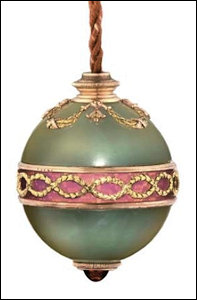 Laurel Vines
Laurel Vines
(C.) Fabergé Bell Pull – М.П.
(Christies, London,
January 24-25, 2007, Lot 411)
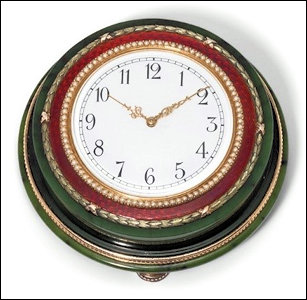 Laurel Vines
Laurel Vines
Fabergé Clock – BA
(Christies, London, November 26, 2018, Lot 212)
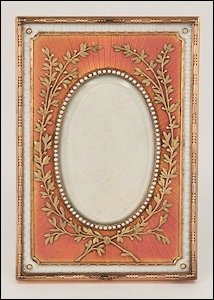 Acanthus Leaves
Acanthus Leaves
Fabergé Frame – BA
(From a Snowflake to an Iceberg:
The McFerrin Collection, 2013, p. 126)
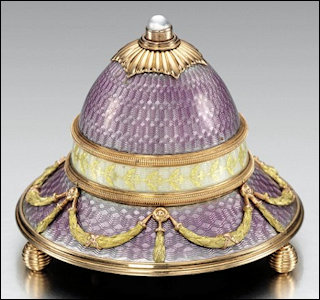 Rosette and Swags
Rosette and Swags
Faberge Bell Push – М.П.
(Sotheby’s, London, November 24, 2008, Lot 20)
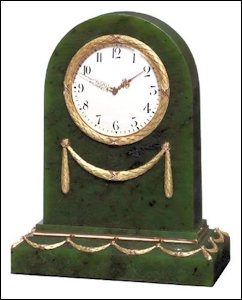 Swags
Swags
Fabergé Clock – H.W. 
(Christies, London, January 24-25, 2007, Lot 440)
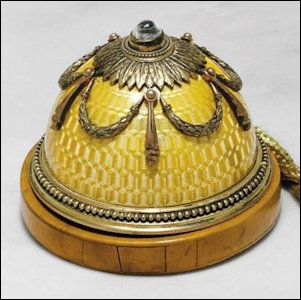 Rosette and Swags
Rosette and Swags
Fabergé Bell Push – BA
(Christies, New York, April 15, 2013, Lot 18)
The use of pre-molded decoration is an ancient technique which has been used by goldsmiths for thousands of years. Tillander-Godenhielm describes their use in more recent times:
“In the specialist workshops, such as those of Fabergé, apprentices and young journeymen were engaged in making strips of gold and silver by the yard stamped and engraved with laurel leaves or ribbon tied garlands. Suitable lengths of these prefabricated strips were cut to measure and were applied to a variety of objects as an elegant finishing touch.”2
(D.) Classical mythological creatures as ornaments
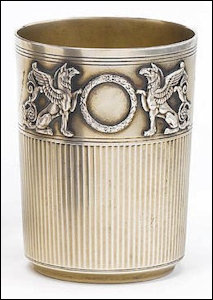 Griffin
Griffin
(D.) Fabergé Cup – BA
(Bonhams, London,
November 24, 2008, Lot 213)
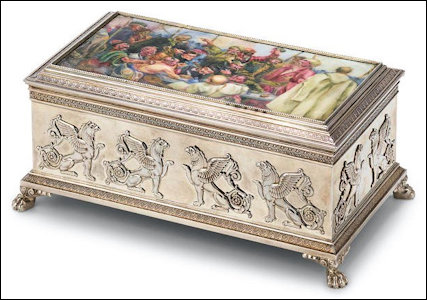 Griffin
Griffin
Fabergé Box – BA
(Bonhams, London, June 9, 2021, Lot 104)
Sphinx
Fabergé Palisander Wood Cigarette Cases
LEFT: М.П. (Royal Collection Trust, RCIN 4049)
RIGHT: H.W.  (Sotheby’s New York, April 17, 2012, Lot 350)
(Sotheby’s New York, April 17, 2012, Lot 350)
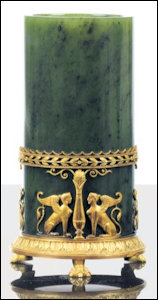 Sphinx
Sphinx
Fabergé Nephrite Vase – М.П.
(Sotheby’s, Paris,
December 19, 2017, Lot 509)
A “collection of wax models of ancient classical ornaments, used extensively by the ornamentors in their work”3 hung on one wall in Wigström’s workshop, opposite the embossers and engravers work stations. Griffin and sphinx are seen in the work of Rappoport (silver cup and en plein enamel box), Perkhin, and Wigström (cigarette cases and vase). The classical lion feet on the box were cast from one mold, a design also frequently used on clocks, bell pushes, and lamps. The identical sphinx image cast in gold on the two cigarette cases and a vase in nephrite have an added Egyptian column, palmettes, and laurel wreath showing the interest in neo-classical motifs and the Egyptomania caused by the 1869 opening of the Suez Canal.
(E.) Lost-wax method, or cire perdue
Fabergé Dolphin Ashtrays in Silver (I.P.  )
)
LEFT: (Sotheby’s, London, June 6, 2017, Lot 345) (Ed. note: Both dolphins are cast in silver, and not embossed as noted incorrectly on the Internet.)
RIGHT: In the Collection of the State Historical Museum, Moscow (Photograph by the Author)
Casting small figural pieces in the round by the lost-wax method or cire perdue is a technique begun in the ancient world. A wax model or statuette is made, then covered with clay or plaster before it is heated until the wax melts and escapes through vents in the mold, leaving a hollow space to be filled with molten metal (silver or gold). When the clay or plaster mold is broken open, a three-dimentional figure emerges. Classical-style dolphins were a motif used extensively by the Fabergé firm to ornament its work. The two pieces (both in silver) from the Moscow workshops of Julius Rappoport are ashtrays in the form of Rennaisance-style dolphins. They are almost identical except for the tip’s position on the tails assuring customers no two Fabergé creations are exactly the same. Fine details are worked by chasing4, engraving, and polishing before they are applied to the piece. Apprentice goldsmiths practice these skills on small decorative pieces like the nephrite cup and the enameled barometer on a bowenite base without fear of making a mistake on a larger more important piece.
The production of multiple identical decorations from casting molds does not diminish the individuality and quality of Fabergé objects. Each piece is still unique! One cannot but admire the talented craftsmen, who trained and worked a lifetime to create such exquisite ojets de vertu.
ENDNOTES:
1 Tillander-Godenhielm, Ulla. Golden Years of Fabergé, 2000, p. 34.
2 Tillander-Godenhielm, Ulla. ”Russia’s Decorative Arts: Inspiration and Execution” in A Gentleman’s Obsession, A Collection of Russian Art by Faberge and His Contemporaries, 2007, p. 159.
3 Tillander-Godenhielm, Ulla. Golden Years of Fabergé, 2000, p. 24
4 In chasing, the front surface of a metal object is decorated by indenting the metal without cutting or engraving the surface. The metal is usually secured in pitch poured into a bowl. A hammer is used to strike a punch-like tool, referred to as a chaser, thereby, indenting the metal.
Changing World of Fabergé Auctions and the Ivory Trade Law
By Timothy Adams (USA)
Significant changes have occurred in the auction world:
-
Hard-copy auction catalogs have been replaced by online catalogs.
-
Advertised “private sales” supplement the traditional auction house functions.
-
Acquisition of smaller auction houses by Bonhams London.
-
New ruling in the United Kingdom for the sale of ivory will have a major impact on the sale of any Fabergé object with an ivory backing. Previous exemptions for antique pieces can no longer be taken for granted. Each piece must be juried by experts.
-
Fabergé auction summary (November 2021 – July 2022).
Hard-copy auction catalogs traditionally retained in art libraries for researchers, and their usefulness for collectors bidding in person, or on the telephone, are now online. Adding to this headache, the confusion of the actual final date of an online auction lasting over several days or weeks followed by a final day of an in-house auction with an auctioneer is discussed in (‘Christie’s website conundrum for Fabergé objects’ in the article entitled, “The Digital Age – 2020 and Beyond, No More Auction Catalogs!” Fabergé Research Newsletter, Winter 2021). And how will the digital data overload be handled in the future? (Murphy, Brian Michael. “Data Storage is Reaching the Limits of Physics”. The Wall Street Journal, August 25, 2022)
Christie’s website offers private sales on its website. Sotheby’s website offers these options: Auctions, private sales, buy now, and retail locations. From May 2022 and for the next five months, a Fabergé cigarette case with a long provenance was offered in a private sale after it did not sell at a Sotheby’s auction, June 9, 2021, Lot 9. Will the descriptive data including provenance disappear when the object sells?
The acquisition of multiple smaller auction competitors by Bonhams London includes Bukowskis (Stockholm), Bruun Rasmussen (Copenhagen), Skinner (USA), and Cornette de Saint Cyr (Paris). The auction world is narrowing down to a few large firms. (Bonhams Press Release)
Ivory Trade Law went into effect on June 6, 2022, in the United Kingdom. Its website states:
“You are dealing in ivory if you:
-
buy, sell, or hire it
-
offer or arrange to buy, sell, or hire it
-
keep it for sale or hire
-
export it from the UK for sale or hire
-
import it into the UK for sale or hire…”
The law will impact any object containing pieces of elephant ivory, i.e., Fabergé photograph frames, miniature paintings, clocks, and more. How will auction houses deal with this new restriction?
Square Green Clock by Fabergé, Workmaster Mikhail Perkhin, St. Petersburg, 1899-1903, Scratched Stock Number 7480 … the ivorine* back with a silver strut
(Christie’s, London, June 6-16, 2022, online auction only, Lot 681 – Ivory Trade Law Began June 6, 2022)
*Ivorine is an ivory simulant made from cellulose nitrate, is a lightweight plastic, sometimes produced with a pattern to imitate elephant ivory.
(Pederson, Maggie Campbell. Gem and Ornamental Materials of Organic Origin, 2004, pp. 73-74)
An exemption clause, which is narrow, allows one to apply for an
exemption certificate under the right circumstances. The text of the law states:
“Exemptions for dealing in ivory
There are 5 narrow and carefully defined exemptions from the ban on dealing in ivory.
This guide explains when you must either:
-
register the item under a standard exemption
-
apply for an exemption certificate for a pre-1918 item that is of outstandingly high artistic, cultural or historical value.
The standard exemptions are for:
-
musical instruments made before 1975 with less than 20% ivory by volume
-
items made before 3 March 1947 with less than 10% ivory by volume
-
portrait miniatures made before 1918 with a surface area smaller than 320 square centimeters
-
items that a qualifying museum intends to buy or hire.
If you consider that your item meets one of the standard exemptions, you must use the declare ivory you intend to sell or hire out service to register the item before you can deal in it.
If you consider that your item meets the exemption criteria of being pre-1918 and of outstandingly high artistic, cultural or historical value, you can use this service to apply for an exemption certificate.”
Once a seller has proven the item is exempt from the law, he has to apply for an exemption certificate which will always be associated with the object. There is a one-time fee of £250. Hence, every Fabergé object containing elephant ivory will need to go through this process before coming up for auction, or is sold by a dealer. My assumption is the auction houses will ask the selling party to get the certificate for its Fabergé piece before the auction house will list the item for sale, thus, saving the auction house or dealer the cost and time to do it in-house. The items will be reviewed by museum experts and scholars in the field to verify they meet the requirements of the law and merit exemption. If there is a rejection, one can appeal the judgment to a higher judicial body along with all the evidence to be considered.
Fabergé Auction Summary (November 2021 – July 2022) from London to Paris, and beyond with brief annotations:
Christie’s, London,
November 29, 2021 The unique collection of Harry Woolf, chairman of Underwoods, the successful London-based pharmacy chain
1, at auction yielded GBP 5,203,250. Sale totals are hammer prices plus buyers’ premium without applicable fees. A small number of hard copy catalogs were printed. The online auction was active through November 28, 2021, a day before the live auction on November 29, 2021. Review on Ruzhnikov website,
December 10, 2021.
Bonhams, London, December 1, 2021 Russian sale contains Fabergé objects.
Bruun Rasmussen, Copenhagen, February 21 and 23, 2022 Buttons and Pendants.
-
Arne Bruun Rasmussen founded the auction house at Bredgade 33 in 1948, and until 2022, the Bruun Rasmussen family owned the company. Today, the company is owned by the British auction house Bonhams – one of the world’s leading and oldest auction houses. Bonhams recently expanded its network to include auction houses Bukowskis, Bruun Rasmussen, Skinner, and Cornette de Saint Cyr. (Bonhams Press Release; The Art Newspaper, March 16, 2022)
Bruun Rasmussen continues to offers its auction catalogs:
-
Sign up for a subscription, and you will automatically receive our catalogues ahead of the Live Auctions in Copenhagen.
-
Buy the catalogues on our website, or order them by phone from our customer service.
-
Download the catalogues at any time from our website.
Bonhams, London, February 23, 2022 Fabergé icon
Freemans’s, Philadelphia, (PA), February 24, 2022 Pomade with scratched stock number 9850
Piquet, Paris, March 1-15, 2022 (no longer online) Silver jardinière
Christie’s, London, March 3-17, 2022 (online auction only) Silver service set for 24 guests
Bonhams, Los Angeles, March 8, 2022 Eight-piece Vodka set
De Baecque, Paris, March 11, 2022 Rectangular box with scratched stock number 22680
Millon Belgique, Brussels, March 27, 2022 Cigarette case (Lot 114), Lot 115 (Ed. note: Re-purposed parasol handle)
Maison R+C, Marseille, Paris, April 5, 2022 Kovsh with scratched stock number 16655
Bonhams, London, April 27, 2022 Pendant
Sotheby’s, London, May 25, 2022 Auction includes 43 Fabergé lots. Reviews on the Ruzhnikov website, May 24, 2022, and May 30, 2022
Millon Belgique, Brussels, May 31, 2022 Assorted objects
Piguet, Paris, June 1-16, 2022 Pendant
Pierre Bergé & Associates, Paris, June 2, 2022 Lots 3, 13, 141
June 6, 2022 UK Ivory Trade Law Went into Effect
Christie’s, London, June 6-16, 2022 (online auction only) Lots 680-688
De Baecque, Paris, June 9, 2022 Presentation brooch (Lot 1) and cigarette case (Lot 14)
Christie’s, Paris, June 23-July 7, 2022 (online auction only) Pair of carafes (Lot 53), Clock (Lot 132)
Koller Auktionen, Switzerland, June 29, 2022 Fabergé objects withdrawn from a Koller auction a third time, more details on the Ruzhnikov website.
Sotheby’s, London, July 5, 2022 Rock crystal ‘Ice’ Red Cross pendant
Jackson’s Auctions, Cedar Falls (IA), July 19, 2022 Icon (Lot 349) and Locket (Lot 379)
Christel McCanless contributed to the Fabergé Auction Summary, additional information with details is appreciated.
ENDNOTES:
1 Memorial for Harry Woolf, the Collector, Fabergé Research Newsletter, Spring 2020.
 Movable Shelving at the Freeman Library, Virginia
Movable Shelving at the Freeman Library, Virginia
Museum of Fine Arts, Richmond (VA)
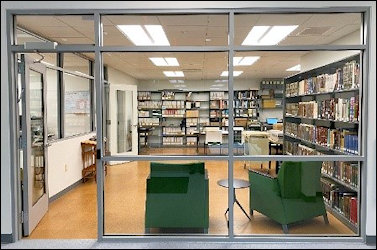 Art Reference Library
Art Reference Library
(Courtesy Hillwood Estate, Museum & Gardens, Washington, DC)
-
Houston Museum of Natural Science, Texas
Update! Gem and Mineral Hall including the exhibition, Everyday Fabergé: The McFerrin Collection Re-opened in the Fall 2023
Begun in 2005, and on extended loan to the Houston Museum of Natural (HMNS) in Texas, the Artie and Dorothy McFerrin Collection of more than 600 Fabergé and Russian decorative art objects has been displayed with descriptive touch panels in a gallery donated by the collectors. A new souvenir booklet, Everyday Fabergé: The McFerrin Collection published by the McFerrin Foundation contains essays with colored illustrations written by six Fabergé enthusiasts: Jennifer McFerrin-Bohner, Dorothy McFerrin, James Hurtt, Timothy Adams, Patricia Hazlett, and Tish Abbey. Summary biographical statements for 12 Fabergé workmasters and the actual marks on the McFerrin objects are a unique teaching tool. Through the generosity of the McFerrin Foundation, a copy of the publication is included in the Summer 2022 edition of this newsletter. The booklet will be available to visitors when the McFerrin Collection reopens late in 2023.
Hazlett, Patricia. “Hidden Treasure: The McFerrin Fabergé Collection” in The Dashing Diplodocus, Spring 2022, p. 19, discusses a Fabergé carved nephrite scent bottle in the shape of a gherkin, or pickle – over the years a favorite of museum guests. Two more articles in the Hidden Treasures series in the docent publication discuss quartz with hematite inclusions and Libyan desert glass (pp. 17-19).
The McFerrin Collection with over 100 Fabergé and Russian smoking accessories is a rich source for research. Fabergé Smoking Accessories: Materials and Techniques of an Art Form, by Christel McCanless and Timothy Adams (PowerPoint Presentation and Handout) was presented at the 2016 Fabergé Symposium in Houston, Texas. Tricia Starks in her 2018 book, Smoking under the Tsars: A History of Tobacco in Imperial Russia, and in her article, “A Community in the Clouds: Advertising Tobacco and Gender in Pre-revolutionary Russia”, gathered background material on this topic. Her contribution to a 2021 publication (The Life Cycle of Russian Things – From Fish Guts to Fabergé, 1600 – Present) includes four cigarette cases from the McFerrin Collection in the chapter, “’Constant Companions’: Fabergé Tobacco Cases and Sensory Prompts to Addiction in Late Imperial Russia”.
Dreher Masterworks exhibition (June 3, 2022 – May 29, 2023) at the Houston Museum of Natural Science (HMNS). Created by four generations of masters from the Dreher family in Idar-Oberstein, Germany, these exquisite pieces are brought to life using ruby, sapphire, aquamarine, topaz and other rare gemstones. Article about the Dreher and Fabergé connection, “Gem Virtuosos: The Drehers and Their Extraordinary Carvings” by Robert Weldon, Cathleen Jonathan, and Rose Tozer, Gemological Institute of America in Gems & Gemology, Winter 2017, Vol. 53, No. 4. During a visit to a previous Dreher exhibition HMNS master docent, Dr. Inda Immega and her fellow volunteers, explained the various materials and techniques used by the gem cutters in Germany and during Fabergé’s time. Valentin Skurlov and Christel Ludewig McCanless responded to questions by Gloria Staebler, author of the 2022 exhibition catalog.
-
Richmond, Virginia.
Virginia Museum of Fine Arts Summary contributed by Courtney Tkacz, Archivist, VMFA
The Margaret R. and Robert M. Freeman Library at VMFA is filled with books, periodicals, and auction catalogs related to the encyclopedic study of art, but we specialize in materials related to Fabergé, Russian decorative arts, and Russian history. Our archives also include related collections including the Lillian Thomas Pratt archives, and the research files for the Lowes, Will and Christel Ludewig McCanless, Fabergé Eggs: A Retrospective Encyclopedia (2001), and the McCanless Audio-visual Collection of Fabergé films from 1971-2017. The library is open by appointment only and can be reached by phone (804-340-1495), or email, and the library catalog and archives catalog are both available online.
If you unable to visit us in Richmond, Virginia, you can still enjoy our resources from home by exploring the digitized Pratt archives as well as digitized rare books including the 1883 Coronation Album of Alexander III and Maria Feodorovna. In addition, VMFA offers a website to explore Pratt’s extensive collection of Fabergé and Russian decorative arts from anywhere in the world.
-
St. Petersburg, Russia.
Fabergé Museum and other Fabergé collections worldwide. Riana Benko (Slovenia) shares her enthusiasm for a
Fabergé: Les Objets Du Désir, a 2021 French movie already shown in Finland and Slovenia.
A beautiful film about Fabergé masterpieces directed by Jean-Pierre Cotett, who wrote the screenplay in collaboration with Mikhail Ovchinnikov, deputy director of the Fabergé Museum, St. Petersburg, Russia, revives the timeless Fabergé masterpieces and connects them to the lives and tragic ending of the Romanov dynasty. Even though I know the whole story about the last Romanov Imperial family, and Carl Fabergé (1846-1920), the Russian Court jeweler, I really enjoyed and liked the entire presentation (52 minutes). The narrator’s voice tells the story in my native language.
Both sides of the two stories are interwoven in an interesting manner. Old film clips of the emperors and their families along with Fabergé and his workshops introduce the famous Fabergé Easter eggs as many of the objects rotate for an all-around viewing. Close-ups often fill the entire TV screen with an art that fascinates and hypnotizes us with its beauty even today as we witness a lost world of art and time.
Dowager Empress Maria Feodorovna (1847-1928) captured Fabergé’s spirit when she received Catherine the Great’s egg in 1914: “Vous êtes un génie incomparable.” The movie lives up to these famous words!
-
Publications
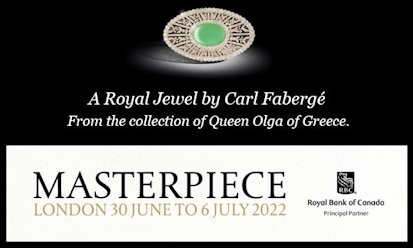 Wartski Advertisement
Wartski Advertisement
(Courtesy Wartski, London)
Marie Betteley discusses her book,
Beyond Fabergé, Imperial Russian Jewelry (2020), in the lecture series sponsored by the Russian History Museum, Jordanville, New York (USA).
1 Book reviews for the joint authors, Marie Betteley and David Schimmelpenninck van der Oye, were shared by Cynthia Coleman Sparke:
-
Fabian Stein in Silver Studies: The Journal of the Silver Society, No. 37, 2021, pp. 169-170. A lavishly illustrated and informative collaboration on Fabergé and contemporaries from a market and academic perspective.
-
Clare Blatherwick in Jewellery History Today, No. 43, Winter 2022, p.18. An overview of the Russian gild system and the Fabergé contemporaries who merit bringing out of the shadows of the legendary firm.
Kishkovsky, Sophia. “Fabergé Egg Allegedly Found by US Officials on $300m Yacht Seized from Russia Oligarch”, The Art Newspaper, July 22, 2022. A photograph of the “egg” has yet to be released, leading to heightened speculation. (Courtesy Erik Schoonhoven) [Ed. note: Many newspapers worldwide carried this story with a variety of Fabergé egg illustrations which are known in other collections, and therefore, not verified by the writers. Mystery not yet solved!]
Korneva, Galina, and Cheboksarova, Tatiana. “Elitnye dragotsennosti na portretakh velikoi knyagini Marii Pavlovny” (Extraordinary Jewels of Grand Duchess Maria Pavlovna on Her Portraits), Khudozhestvennyi Vestnik (Art News), Issue 8, 2021, pp. 95-115, includes new discoveries with Fabergé illustrations. (Courtesy of the Authors and Evgeny Pylayev)
-
#14 = 1902 von Dervis display case with “not less than 14 flower studies”
-
#17-18 = 36 silver plates
-
#19-21 = 2 cigarette cases courtesy of the McFerrin Collection, and a Fabergé invoice, and
-
#22 = Smoker’s compendium and Silver Fire composition. An earlier research report by the authors appeared in “Silver Wedding Anniversary Gifts for Grand Duchess Maria Pavlovna and Grand Duke Vladimir Alexandrovich. Where Are the Fabergé Objects Now?” (Fabergé Research Newsletter, Summer 2015)
The website, Miek’s Fabergé Eggs, is no longer maintained and updated by its dedicated researcher, the late Annemiek Wintraecken. She left us with these thoughts: “It was great to share my passion of Fabergé Eggs with so many of you. My time is up, but as we all know, the internet is forever, and so is Fabergé!” At present, the website’s historical data is online through the generosity of her family.
Nicholas II | Apartments in the Winter Palace | Private Quarters of the Imperial Couple (YouTube video shared by Juan Déniz, who challenges readers to search for Fabergé objects.)
Sparke, Cynthia Coleman studied the narrowing dates of production and stylistic themes for Fabergé presentation silver using kovshes tied to historical events or diplomatic gifting. “Russia’s Silver Emissaries.” Silver Studies: The Journal of the Silver Society, No. 37, 2021, pp. 30-35.
Trombley, Margaret Kelly. Fabergé and the Russian Crafts Tradition: an Empire’s Legacy, 2017. Book Review by Caroline de Guitaut. Jewellery History Today, 35 – Spring 2019. (Courtesy of Cynthia Coleman Sparke)
Fabergé Dealers
-
A La Vieille Russie, New York City – Silver Mounted Sandstone Elephant by Rappoport for Fabergé (Apollo, December 2021, p. 73); ALVR Gallery.
-
Bentley and Skinner, London – Website has two parts for objects, available and sold.
-
André Ruzhnikov, London – Three Flower Studies in Rock Crystal Vases by Fabergé (Apollo, December 2021, p. 75); Fabergé Works of Art, and Publications summarizing specific categories of Fabergé objects, i.e., cigarette cases, clocks, etc.
-
John Atzbach Antiques – Fabergé and Russian objects shown with many illustrations, and a sold category.
-
Romanov Russia – Research data and illustrations highlight objects.
-
Wartski, London – Exhibitor at the Masterpiece Art Fair, June 30 – July 6, 2022 (Advertisement Courtesy Wartski, London); Website.
Book Dealer
John Emerich, proprietor of the Bronze Horseman Books located in Larchmont (NY), imports Eastern European art history and museum publications from Russia, Finland, Georgia, Ukraine, and Moldova:
-
Tatiana Muntian, Marina Gor’kova, et al. Carl Fabergé and Feodor Rückert. Masterpieces of Russian Enamel. Exhibition catalogue / Karl Faberzhe i Fedor Riukert. Shedevry russkoi emali. Katalog vystavki. Moscow: Muzei Moskovskogo Kremlia, 2020.
-
T. N. Muntyan. Fabergé Easter Gifts / Faberzhe: Paskhal’nye podarki. Moscow: Muzei Moskovskogo Kremlia, 2018.
-
Fabergé Museum in St. Petersburg: Exhibit Index / Muzei Faberzhe v Sankt-Peterburge: ukazatel’ po ekspozitsii. St. Petersburg: Muzei Faberzhe, 2014.
-
Matalia Mavrodina, Liudmila Gavrilova. Carl Fabergé and Masters of Stone Carving. Russian Gems / Karl Faberzhe i mastera kamnereznogo dela. Samotsvetnye sokrovishcha Rossii. Moscow: Muzei Moskovskogo Kremlia, 2011.


